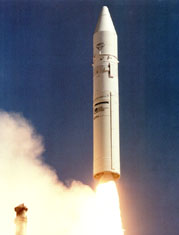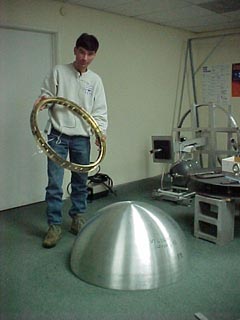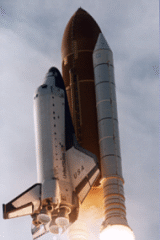STARSHINE 3 UPDATE - April 22, 2001
STARSHINE 3 UPDATE - April 22, 2001
|
 Photo by Lockheed Martin Click for larger image |
We have received 1200 student-polished mirrors for Starshine 3 from schools
all over the world. The Space Optics Manufacturing Technology Center at the
Marshall Space Flight Center is in the process of applying a clear protective
coating of silicon dioxide to the surfaces of these mirrors. They will then
ship them to the Naval Research Laboratory in Washington, DC for installation
on the satellite. We will add another 300 professionally polished mirrors
from Hill Air Force Base, Ogden, Utah, to bring the total up to 1500 mirrors.
This will improve the sunlight flash rate and make the satellite more
visible at twilight as it orbits the earth.
Starshine 3 will fly on NASA's Kodiak Star mission out of the Kodiak Launch Complex, Alaska, on August 31, 2001. The unmanned launch vehicle for this mission will be a Lockheed Martin Athena I. |
|
This launch will place Starshine
3 in a 500 kilometer (300 mile) circular orbit, inclined to the equator by 67
degrees. This means that the satellite will be visible during certain
twilight periods to all the children in the world as it orbits the earth for
several years. The satellite will be deployed from the launch vehicle by a
Lightband system being built by Planetary Systems Corporation in Silver
Springs, MD. After certifying this deployment system on the Kodiak Star
mission, we later plan to use it to deploy other Starshine satellites from
Space Shuttle orbiters, and, possibly, Evolved Expendable Launch Vehicles.
Starshine 3 is nearly a meter in diameter (37 inches) and weighs 88 kilograms (193 pounds). It will carry 1500 polished mirrors, 31 laser retroreflectors, and seven clusters of solar cells and thin film batteries from the NASA Glenn Research Center in Cleveland, OH. The solar cells will power an amateur radio transmitter being built by Cynetics Corporation and the South Dakota School of Mines and Technology in Rapid City, SD. This transmitter will send out a beacon signal every sixty seconds at a frequency of 145.825 Megahertz to amateur radio operators, or "hams," all over the world.
|
 Photo by Walter Holemans Click for larger image |
|
The beacon signal
will contain information that will allow the hams to measure the spin rate of
the satellite and the performance of the solar cells and batteries.
The Naval Research Laboratory in Washington, DC is building the satellite,
with assistance from the Bridgerland Applied Technology Center in Logan,
Utah, the Robert C. Byrd Institute of Huntington, WV, Mr. Douglas Winfield of
Seneca, SC, the C. F. P. Paul Rousseau School in Drummondville, Quebec,
Canada, and the Calhoun Community College in Decatur, Alabama. This latter
institution has just completed machining nearly two thousand holes in the
skin of the hollow aluminum hemispheres that make up the structural shell of
the Starshine 3 satellite.
|
STARSHINE 2 UPDATE - May 5, 2001
|
|
The Space Shuttle STS-108 launch, with our Starshine 2 satellite aboard, has been postponed until November 29, 2001. Engineers at the Naval Research Laboratory have completed the installation of 845 student-polished mirrors, 31 laser retrorefectors and 2 micro-jet thrusters on the surface of the Starshine 2 satellite shell in a clean room at their satellite assembly facility. They are also completing the construction and assembly of a pressure vessel and valve that will work with the micro-jet thrusters to spin Starshine 2 at the start of its orbital mission. Schools in the vicinity of the Naval Research Laboratory in southeast Washington, DC can make arrangements to visit the laboratory and watch their mirrors being vibration tested on the Starshine 2 satellite. Due to the aforementioned delay in the launch schedule, this vibration test may be postponed until sometime in May. Teachers wishing to schedule a visit should send an email message to Mr. Bill Braun, Starshine Spacecraft Program Manager, at braun@space.nrl.navy.mil or call him at 202-767-0695. |
 |
|
We have submitted a request to NASA to manifest two additional Starshine satellites on the STS-113 mission in August, 2002, and the request is proceeding smoothly through the approval chain. Please direct your questions about any facet of the Starshine program to Gil Moore, Director, Project Starshine, 3855 Sierra Vista Road, Monument, CO 80132, telephone (719) 488- 0721, email gilmoore12@aol.com .
|